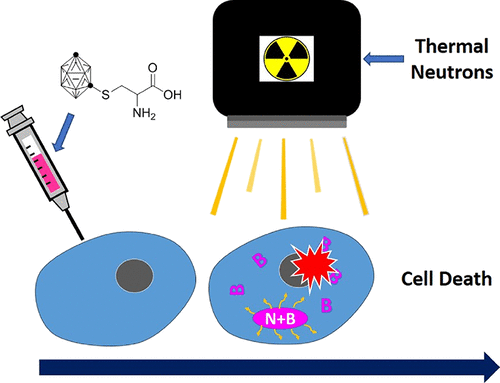Our official English website, www.x-mol.net, welcomes your
feedback! (Note: you will need to create a separate account there.)
Evaluation of the Potential of 2-Amino-3-(1,7-dicarba-closo-dodecaboranyl-1-thio)propanoic Acid as a Boron Neutron Capture Therapy Agent
ACS Omega ( IF 3.7 ) Pub Date : 2019-02-21 00:00:00 , DOI: 10.1021/acsomega.8b03407 Tianyu He 1 , Rabi A. Musah 1
ACS Omega ( IF 3.7 ) Pub Date : 2019-02-21 00:00:00 , DOI: 10.1021/acsomega.8b03407 Tianyu He 1 , Rabi A. Musah 1
Affiliation

|
A novel boron-rich α-amino acid (3) that serves as a boron delivery agent for boron neutron capture therapy (BNCT) has been designed and synthesized by substituting the side chain of cysteine with m-carborane. The uptake of this compound into neuronal U87 cells was determined by inductively coupled plasma-optical emission spectrometry (ICP-OES) and showed intracellular concentrations of elemental boron at the picogram/cell level. To assess the cell-killing effect of 3, U87 cells were incubated with varying concentrations of 3 and 1 mM of the known BNCT agent 4-borono-l-phenylalanine (BPA) for comparison. Cells were subsequently exposed to radiation with thermal neutrons at fluences varying from 1 × 108 to 2 × 109 neutrons/cm2. Prior to neutron beam exposure, no cytotoxic effect was observed for BPA-treated cells, while a modest cytotoxic effect was observed for cells incubated with concentrations of 3 varying from 1 μM to 1 mM (resulting in cell viability reductions from 2.1% to 12.5%, respectively, relative to the control). An enhanced cell-killing effect (with a cell viability reduction of up to 47.8% relative to the control) was observed when 3-treated cells were irradiated with thermal neutrons. This was attributed to the impact of α particle formation from 3 in response to neutron beam exposure. Lower concentrations of 3 exhibited a superior cytotoxic effect relative to BPA and at reduced levels of neutron fluences when compared to that used in conventional treatment. This work suggests the potential for a novel “chemo-radiotherapy” approach to the treatment of cancer by BNCT, whereby a 1000-fold lower neutron radiation fluence compared to typical BNCT can be used.
中文翻译:

2-氨基-3-(1,7- dicarba-的潜力评价闭合碳-dodecaboranyl -1-硫代)丙酸,为硼中子俘获治疗剂
一种新颖的富硼α氨基酸(3充当硼递送剂用于硼中子俘获治疗)(BNCT)已被设计,并通过与代半胱氨酸的侧链合成米-carborane。通过电感耦合等离子体发射光谱法(ICP-OES)确定了该化合物对神经元U87细胞的摄取,并在皮克/细胞水平上显示了元素硼的细胞内浓度。为了评估的细胞杀伤效果3,U87细胞用不同浓度的孵育3和已知BNCT剂4-borono- 1mM的升-苯丙氨酸(BPA)用于比较。随后将细胞以1×10的不同通量暴露于热中子辐射8至2×10 9中子/ cm 2。在中子束暴露之前,未观察到BPA处理过的细胞有细胞毒性作用,而浓度为3的细胞在1μM至1 mM范围内均未观察到适度的细胞毒性作用(导致细胞活力从2.1%降低至12.5%)相对于对照)。当用热中子辐照3-处理的细胞时,观察到增强的细胞杀伤作用(相对于对照,细胞活力降低高达47.8%)。这归因于响应中子束曝光从3开始形成α粒子的影响。较低浓度的3与常规治疗相比,具有相对于BPA优异的细胞毒性作用,并且中子注量水平降低。这项工作表明了通过BNCT治疗癌症的新型“化学放射疗法”方法的潜力,因此可以使用比典型BNCT低1000倍的中子辐射通量。
更新日期:2019-02-21
中文翻译:

2-氨基-3-(1,7- dicarba-的潜力评价闭合碳-dodecaboranyl -1-硫代)丙酸,为硼中子俘获治疗剂
一种新颖的富硼α氨基酸(3充当硼递送剂用于硼中子俘获治疗)(BNCT)已被设计,并通过与代半胱氨酸的侧链合成米-carborane。通过电感耦合等离子体发射光谱法(ICP-OES)确定了该化合物对神经元U87细胞的摄取,并在皮克/细胞水平上显示了元素硼的细胞内浓度。为了评估的细胞杀伤效果3,U87细胞用不同浓度的孵育3和已知BNCT剂4-borono- 1mM的升-苯丙氨酸(BPA)用于比较。随后将细胞以1×10的不同通量暴露于热中子辐射8至2×10 9中子/ cm 2。在中子束暴露之前,未观察到BPA处理过的细胞有细胞毒性作用,而浓度为3的细胞在1μM至1 mM范围内均未观察到适度的细胞毒性作用(导致细胞活力从2.1%降低至12.5%)相对于对照)。当用热中子辐照3-处理的细胞时,观察到增强的细胞杀伤作用(相对于对照,细胞活力降低高达47.8%)。这归因于响应中子束曝光从3开始形成α粒子的影响。较低浓度的3与常规治疗相比,具有相对于BPA优异的细胞毒性作用,并且中子注量水平降低。这项工作表明了通过BNCT治疗癌症的新型“化学放射疗法”方法的潜力,因此可以使用比典型BNCT低1000倍的中子辐射通量。


















































 京公网安备 11010802027423号
京公网安备 11010802027423号